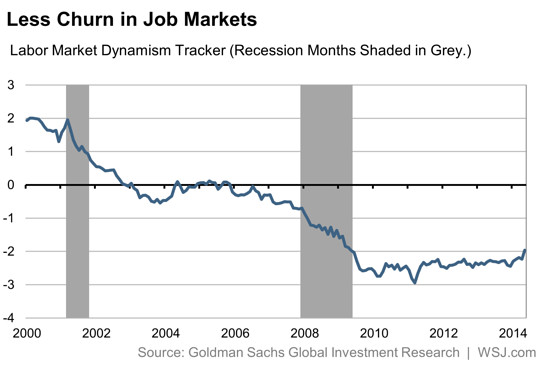July 7, 2014, 3:53 PM ET - Wall Street Journal
Fewer People Are Quitting Their Jobs, And Why Thatfs Not Good
By Kathleen Madigan

Payroll growth finally has taken off this year, rising solidly above 200,000
jobs per month in the first six months.
But what lies beneath the headline number says a lot about the economic
outlook. Economists at Goldman
Sachs set out to gauge how dynamic the current
labor markets are. What they found is therefs much less job movement than there
would be in a fully healthy economy. Businesses adding and losing workers and
people quitting and taking other jobs–what economists call gchurnh—are generally
good measures of economic confidence.
Goldman constructed a labor-market dynamism tracker using data from a range
of government sources. They took the hiring and separation rates in the Job Openings and Labor
Turnover survey, the sum of the gross job-gain and job-loss rates from the Business Employment
Dynamics report, and the share of workers making job-to-job transitions in
the employment
reportes household survey. (The tracker prior to the mid-1990s relies on
annual household survey data.)
The tracker finds labor-market dynamism ghas fallen substantially since
2000.h Dynamism rebounded only weakly in the last two recessions, compared to
much stronger bouncebacks following the recessions in the 1980s and 1990s.
Companies are laying off far fewer workers, but the hiring rate has recovered
only partly from the recession. People are quitting less often, and workers show
a greater tendency to stay put. Although some of the reduced churn reflects
structural effects, gthe decline seems mostly cyclical in nature,h writes
David Mericle, a U.S. economist at Goldman.
Does a less dynamic labor market matter if top-line job growth is doing well?
Yes, the report says.
First, a more static labor market gis likely to see weaker wage and
productivity growth.h
Workers may stay put in jobs that donft use their skills to the best effect.
That mismatch reduces an employeefs ability to negotiate pay raises and also
reduces his or her productivity. In addition, the Goldman report notes other
research showing a large share of an individualfs wage gains comes from
switching employers.
Second, less churn exacerbates the challenges faced by the long-term
unemployed.
gA labor market with little turnover is naturally more difficult to enter for
those not currently employed,h Mr. Mericle writes.
According to Labor Department data, in this recovery, the longer a person is
out of work, the lower the chances of finding a new job. In addition to the
personal and government costs of long-term unemployment, a large number of
permanently unemployed workers reduces the U.S. economyfs potential output.
Add that drag to weaker wage and productivity growth, and itfs easy to see
why the Federal Reserve is concerned about labor-market churn.
gWe suspect that such concerns lie behind Chair[woman Janet]
Yellenes inclusion of the hiring and quits rate in her edashboardf of
labor market indicators,h Mr. Mericle concludes.
Indeed, Ms. Yellenfs dashboard is why Tuesdayfs Job Openings and Labor
Turnover report, once an also-ran among economic data, has become a must-read
release among Fed watchers.